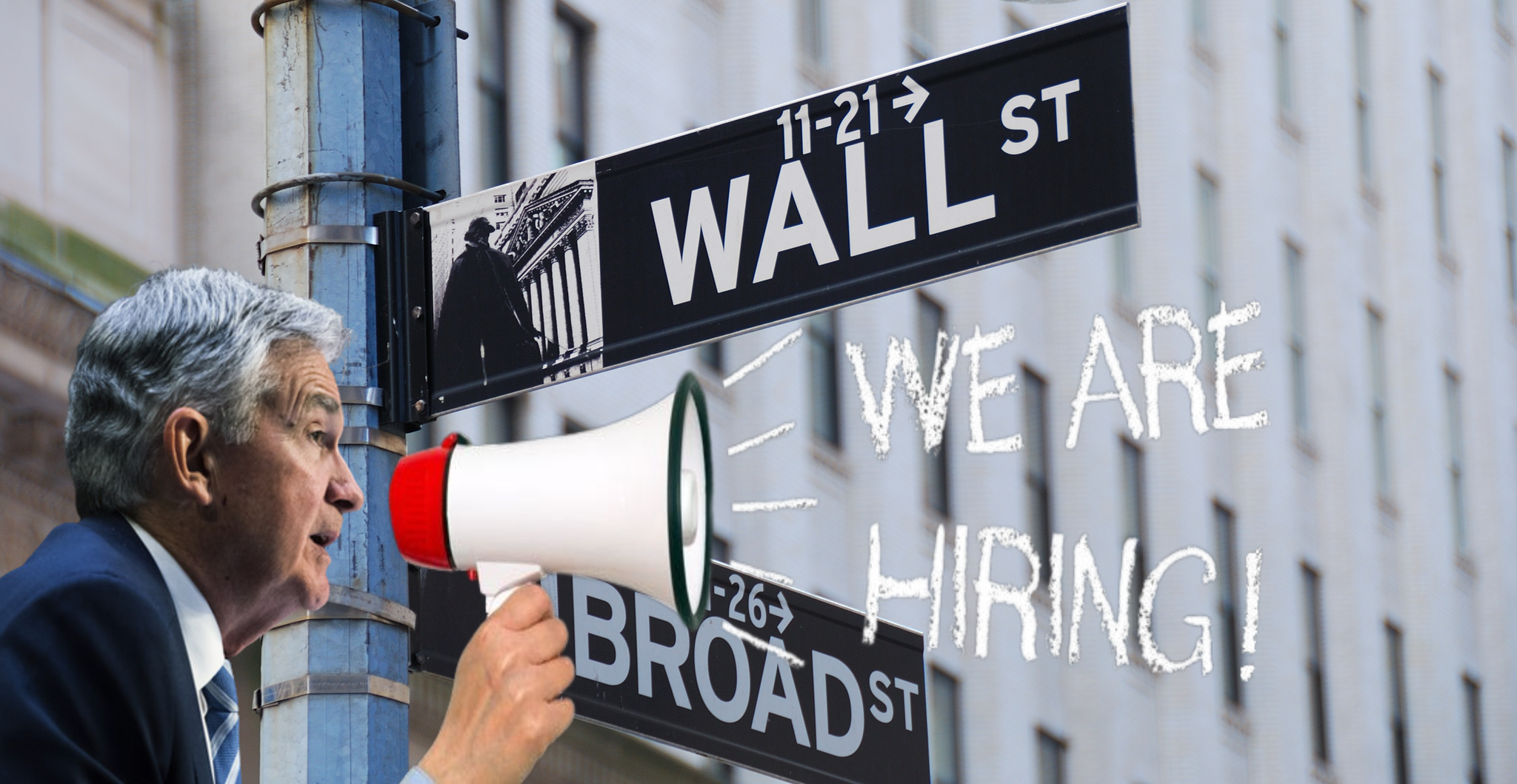
US Labor Market Stirs Financial Turmoil, Fuels Speculation on Fed's Move
Strong jobs data triggers a surge in Treasury bond yields, rocks the equity market, and signals potential tightening by the Federal Reserve| That's TradingNEWS
The resilience of the US labor market has taken center stage in recent days, with indicators and expert analysis pointing towards a late-cycle surge in new hiring that has Treasury bond yields pushing past critical levels. As the clock ticks closer to the release of Friday's June jobs report, the financial market is palpably tense, given the implications these job figures will carry.
2-year U.S. Treasury yield has reached a level unseen in 16 years, with investors keenly tracking strong jobs data that may indicate further tightening by the Federal Reserve. The yield jumped by almost 4 basis points, landing at a notable 4.987%. During the trading session, the yield hit a high of 5.120% - a figure last surpassed back on June 15, 2007, when it soared to 5.121%. Not to be outdone, the 10-year Treasury yield was last spotted at 4.035% after a leap of 9 basis points.
A vital understanding of the bond market is that yields and prices have an inverse relationship. This rise in yields signifies a decrease in the prices of the underlying bonds, with one basis point equating to 0.01%.
An analysis of the jobs data reveals interesting trends. The natural resources and mining sector added a robust 69,000 jobs while construction added a further 97,000. However, the manufacturing industry shed 42,000 jobs. Among the service-providing industries, leisure and hospitality experienced a significant increase, adding 232,000 jobs, while trade, transportation, and utilities saw an addition of 90,000 jobs. Nevertheless, not all sectors showed progress; finance and professional services reported declines.
Commenting on the employment landscape, Nela Richardson, chief economist at ADP, highlighted that while job creation surged in June, the market was still fragmented. "Consumer-facing service industries had a strong June, aligning to push job creation higher than expected,” Richardson said. “However, wage growth continues to ebb in these same industries, suggesting hiring may be reaching a peak after a late-cycle surge.”
Economists are now grappling with divergences in the economy, with discrepancies between GDP and Gross Domestic Income (GDI), as well as between job growth and employment numbers. With manufacturing signaling a potential recession, these anomalies add to the complexity of the situation.
The bullish ADP report has only added fuel to the fire, with certain sectors such as manufacturing, information, financial activities, and professional services experiencing difficulties despite the overall positive outlook. The implications of the report on the Federal Reserve's decisions are significant, particularly regarding future rate hikes.
Indeed, bond yields across the board are rising, with the 10-year yield, 5-year yield, and 30-year yield increasing 11, 14, and 10 basis points respectively. At the same time, major US stock market indexes - the DOW, Nasdaq, and S&P 500 - are witnessing a downward trend, each dropping by about one percent.
But it isn't all doom and gloom. The US economy had a significant surge in new private sector hiring in the past month, according to payroll processing group ADP. The group's National Employment Report showed private sector jobs growth of 497,000 last month, far surpassing Street forecasts of a 228,000 gain. This development may strengthen the Federal Reserve's case for further interest rate hikes in the coming months.
However, not all trends are moving upwards. ADP reported wage gains slowing to 6.4% for those staying at their current job, with gains for job-changers slipping to 11.2% - the slowest since October 2021. This data point may be critical in informing Friday's May employment report, which is anticipated to show a decrease in hiring compared to the previous month.
The news caused a stir in the US stock market, with the S&P 500 falling 59 points in the initial hours of trading, and the Dow Jones Industrial Average experiencing a 3492 points pullback. The tech-focused Nasdaq wasn't spared either, with a drop of 205 points.
Given the market turbulence, the 10-year Treasury notes yield increased 10 basis points, reaching 4.061% - the highest since early March. In parallel, the 2-year notes surged past the 5% mark to 5.097%, a level not seen since 2007, before retreating to 4.059%.
This period of economic uncertainty also saw the U.S. dollar index falling 0.169% against a basket of global currency peers. However, market speculation is now rife, with the CME Group's FedWatch indicating a 96% chance of a 25 basis point hike later this month, a jump from 81.6% at the close of trading on June 30. With bets on another rate hike in November hovering around 50%, the market seems to be in a wait-and-see mode, looking for clearer signs of where the economyis headed.
Breaking down the employment figures further, we see a substantial growth in the natural resources and mining sector, boasting an addition of 69,000 new jobs. Construction trailed closely behind with an impressive 97,000 jobs created, bolstering the sector's continued recovery. However, in the face of this progress, the manufacturing sector took a hit, losing 42,000 jobs in the past month.
Within the services sector, a significant surge in hiring was observed across multiple industries. The trade, transportation, and utilities sector brought on an additional 90,000 jobs. Education and health services followed suit with 74,000 new positions filled. The biggest winner, however, was the leisure and hospitality sector, with an astounding 232,000 jobs created.
On the flip side, not all industries witnessed growth. Sectors like information, financial activities, and professional and business services reported job declines. Nela Richardson, ADP’s chief economist, emphasized this market divergence. While the consumer-facing service industries had a strong showing in June, wage growth was lagging in these very sectors. Richardson observed, "These industries that are pushing job creation higher than expected are simultaneously experiencing a deceleration in wage growth.”
Despite the overall robust picture painted by the labor market, economists are noting some unusual disparities. Job numbers and employment figures are seemingly at odds, with job growth outstripping employment growth by a significant margin. As economists grapple with the meaning of these discrepancies, some speculate we might be entering uncharted territory in economic history.
All these factors have amplified speculation about the Federal Reserve's next move. Fed-watchers and market participants are closely eyeing the possibility of further tightening, with the robust labor market data fueling anticipation of a more hawkish stance. The CME Group's FedWatch tool, which calculates the probability of rate moves based on futures pricing, now suggests a 96% likelihood of a 25 basis point hike later this month. This is up from an 81.6% chance at the end of June.
Ironically, the robust labor market data has not been well-received by the equity markets. Following the release of the ADP data, US stocks extended their declines. The S&P 500 fell 59 points in early trading, while the Dow Jones Industrial Average retreated by a sizeable 3492 points. The tech-heavy Nasdaq was also in the red, falling 205 points. Shares of tech giants, including Intel Corporation and Qualcomm Incorporated, were under pressure, sliding 3% and 2.4% respectively.
Furthermore, the U.S. dollar index, which measures the greenback against a basket of six other major currencies, dropped 0.169%.
Ahead, market players are waiting with bated breath for Friday's May employment report. Forecasts predict a slowing down in hiring compared to the previous month, with 225,000 new jobs expected. Moreover, the monthly average hourly earnings are anticipated to ease to 0.3%.
Stock markets continue to experience turbulence with major US stock market indexes, including the DOW, Nasdaq, and S&P 500, all down about one percent. These losses were exacerbated by specific sector challenges, such as the aviation industry, where JetBlue Airways Corporation announced that it would terminate its alliance with American Airlines. The airline plans to focus on its acquisition of Spirit Airlines, a move which resulted in its stocks tumbling by 6.4%.
In spite of the market's volatile reactions, the labor market data itself presents an optimistic picture. ADP's report revealed a surge of 497,000 private sector jobs in June, far surpassing the Dow Jones consensus estimate of 220,000. This surge, the largest monthly rise since July 2022, was led by sectors such as leisure and hospitality (adding 232,000 new hires), construction (97,000 new hires), and trade, transportation and utilities (90,000 new hires).
Nevertheless, amidst the good news, some dark clouds remain. Despite the substantial job creation, wage growth continues to slow, stoking fears of future inflationary pressures. Furthermore, the Federal Reserve's multiple interest rate hikes over the past year, designed in large part to cool a jobs market with nearly two open positions for every available worker, continue to echo through the economy. The overall picture remains complicated, with June's jobs growth lower than expected, which could potentially ease worries about further Federal Reserve rate hikes. This dynamic interplay between the labor market, Federal Reserve policy, and market reactions underscores the intricate complexity of economic forecasting.
That's TradingNEWS
Read More
-
Pagaya Stock Price Forecast - PGY at $23.20: Is PGY Stock the Cheapest AI Fintech of 2026?
19.12.2025 · TradingNEWS ArchiveStocks
-
XRP Price Forecast: XRP-USD Stuck at $1.87 With $3 2026 Target and $10–$25 Long-Term Range
19.12.2025 · TradingNEWS ArchiveCrypto
-
Oil Price Forecast: WTI Near $56 and Brent at $60 Signal Risk Toward $50
19.12.2025 · TradingNEWS ArchiveCommodities
-
Stock Market Today: AI Chip Rally Lifts Nasdaq as $7.1T Quad Witching Hits
19.12.2025 · TradingNEWS ArchiveMarkets
-
GBP/USD Price Forecast - Pound at 1.34 As BoE Cut And Soft Dollar Keep Bullish Path Toward 1.35
19.12.2025 · TradingNEWS ArchiveForex



















